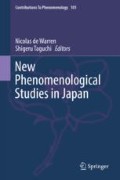Abstract
We often expect Husserl’s concept of intentionality to be the key to opening our minds to the world. The phenomenological sphere of consciousness is not a closed encapsulated sphere, but open to the world. The phenomenological method, however, forbids appealing to naïve realism exclusively as it concentrates on immanently accessible conscious experiences. How can these two features be compatible with one another? This paper examines this question while seeking to justify Husserl’s claim that an intentional object is the real and actual object itself, and transcendent in the sense that it is beyond our grasp of meanings.
Access this chapter
Tax calculation will be finalised at checkout
Purchases are for personal use only
Notes
- 1.
This means “we cannot experience it within our actual concrete experiences,” and not in the sense that it is an inaccessible possible world with respect to an accessible relation in the framework of possible world semantics.
- 2.
A decidable procedure is a well-defined inscription which ensures the answer can be determined as yes or no within finite steps in all cases, and a semi-decidable procedure ensure the answer yes within finite steps in positive cases. See, for example, Enderton 2001, pp. 61–65.
References
Bell, David. 1990. Husserl, The Arguments of the Philosophers. London: Routledge.
Dummett, Michael, Frege’s Distinction Between Sense and Reference. In Dummett, 1978, 116–144.
———. 1978. Truth and Other Enigmas. Cambridge, MA: Harvard University Press.
———. 1991. The Logical Basis of Metaphysics, William James Lectures: 1976. Cambridge, MA, Harvard University Press.
Enderton, Herbert B. 2001. A Mathematical Introduction to Logic, 2nd edn. Oxford: Harcourt Academic Press.
Hintikka, Jakko. 1975. The Intentions of Intentionality and Other New Models for Modalities. Dordrecht: Reidel.
Simons, Peter. 1995. Meaning and Language. In ed. Barry Smith et al., 106–137.
Smith, Barry, and David Woodruf Smith, eds. 1995. Cambridge Companion to Husserl. Cambridge: Cambridge University Press.
Sokolowski, Robert. 2000. Introduction to Phenomenology. Cambridge: Cambridge University Press.
Author information
Authors and Affiliations
Editor information
Editors and Affiliations
Rights and permissions
Copyright information
© 2019 Springer Nature Switzerland AG
About this chapter
Cite this chapter
Tomiyama, Y. (2019). On the Transcendence and Reality of Husserlian Objects. In: de Warren, N., Taguchi, S. (eds) New Phenomenological Studies in Japan. Contributions To Phenomenology, vol 101. Springer, Cham. https://doi.org/10.1007/978-3-030-11893-8_4
Download citation
DOI: https://doi.org/10.1007/978-3-030-11893-8_4
Published:
Publisher Name: Springer, Cham
Print ISBN: 978-3-030-11892-1
Online ISBN: 978-3-030-11893-8
eBook Packages: Religion and PhilosophyPhilosophy and Religion (R0)

